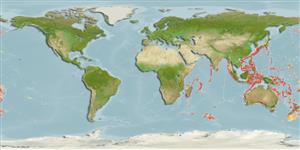Environment: milieu / climate zone / depth range / distribution range
Écologie
marin bathydémersal; profondeur 256 - 711 m (Ref. 35812). Deep-water
Indo-West Pacific: Zanzibar, Tanzania and Madagascar to southern Japan and the Philippines.
Taille / Poids / Âge
Maturity: Lm ? range ? - ? cm
Max length : 23.0 cm SL mâle / non sexé; (Ref. 26165)
Rarely caught.
Life cycle and mating behavior
Maturities | Reproduction | Spawnings | Egg(s) | Fecundities | Larves
Quéro, J.-C. and C. Ozouf-Costaz, 1991. Ostracoberyx paxtoni, nouvelle espèce des cötes est de l'Australie. Remarques sur les modifications morphologiques des Ostracoberyx au cors de leur croissance (Perciformes, Ostracoberycidae). Cybium 15(1):43-54. (Ref. 35812)
Statut dans la liste rouge de l'IUCN (Ref. 130435)
Menace pour l'homme
Harmless
Utilisations par l'homme
Outils
Articles particuliers
Télécharger en XML
Sources Internet
Estimates based on models
Preferred temperature (Ref.
123201): 6.8 - 14.5, mean 10.3 °C (based on 340 cells).
Phylogenetic diversity index (Ref.
82804): PD
50 = 0.7500 [Uniqueness, from 0.5 = low to 2.0 = high].
Bayesian length-weight: a=0.01995 (0.00906 - 0.04395), b=3.01 (2.83 - 3.19), in cm total length, based on all LWR estimates for this body shape (Ref.
93245).
Niveau trophique (Ref.
69278): 3.5 ±0.5 se; based on size and trophs of closest relatives
Fishing Vulnerability (Ref.
59153): Low vulnerability (18 of 100).
